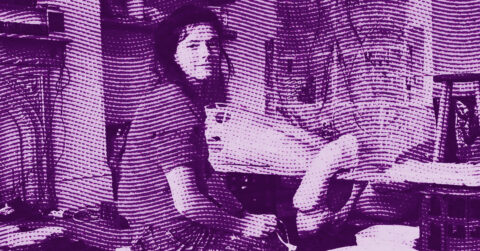Listen to me carefully, you bunch of snobs. Nina Chanel Abney holds up a distorted mirror of our era, where Picasso’s modernity’s vanishing points meet the immediate brutality of the contemporary digital image. This American artist, born in 1982 in Chicago, has been deploying for two decades a visual language that challenges our certainties with the force of a punch in the stomach and the sophistication of a jazz score.
The Architecture of Chaos: A Reinvented Modernity
When Abney reclaims the cubist heritage, she does not simply quote Picasso or Braque. She diverts their formal innovations to create a plastic vocabulary resolutely anchored in the 21st century. Her fragmented compositions evoke less the Demoiselles d’Avignon than the shattering of our screens, the proliferation of our information flows, the saturation of our Instagram feeds. This kinship with historical cubism is neither nostalgic nor reverent: it is strategic.
The artist borrows from European modernity its tools of formal deconstruction to analyze contemporary power structures. Her geometrized figures, with sharp contours and saturated colors, seem to escape from a digital universe where emojis contest territory with conceptual art. This aesthetic of apparent simplification masks a formidable narrative complexity. Each of Abney’s canvases functions as a visual testimony where pop references, social critique, and identity questioning overlap.
In Catfish (2017), she orchestrates a ballet of nude bodies over 5.5 meters, simultaneously evoking the spirit of the Demoiselles d’Avignon and the culture of erotic selfies. This masterful work perfectly illustrates Abney’s method: starting from a canonical artistic referent to question our most prosaic contemporary behaviors. The bodies of her characters, reduced to their essential geometric components, become ideograms of desire and commodification.
This neo-cubist approach allows the artist to go beyond the limits of traditional representation. By fragmenting her subjects, she frees them from fixed identity assignments. Her characters with stylized faces and angular bodies escape conventional racial or gender categorizations, creating an interpretative freedom space that few contemporary artists manage to maintain with such consistency.
The use of simple geometric shapes, circles, triangles, and rectangles, is never gratuitous with Abney. It is a visual grammar that makes it possible to construct complex narratives from elementary formal elements. This economy of means, inherited from the historical avant-gardes, serves here a contemporary critical discourse of rare acuity. The artist thus demonstrates that formal innovation can still be a vector of political subversion, provided one knows how to articulate it to a demanding worldview.
The Poetics of Immediacy: An Aesthetic of Urgency
Abney’s work maintains osmotic relationships with contemporary poetry. Like some poets of her generation who practice digital cutting or syntactic fragmentation, she proceeds through semantic collisions and visual overlaps. Her canvases function according to a logic close to that of free verse: they organize their elements according to an internal rhythm that escapes the classical rules of composition.
This kinship with poetic writing is particularly evident in her use of text. Truncated words, acronyms, onomatopoeias emerge in the middle of her compositions like free verses inscribed in the pictorial material. In Untitled (FUCK TE OP) (2014), the textual fragments, “BLACK”, “KILL”, “WOW”, punctuate the visual space with the impactful force of a protest poem. These linguistic insertions are never redundant with the image; on the contrary, they create effects of meaning through friction, in the manner of the best contemporary poets who make meaning emerge from the collision of heterogeneous registers.
The artist masters the art of semantic shortcut, this ability to condense complex networks of meanings into a single image. Her titles participate in this poetics of condensation: Miss Opportunity, Sea & Seized testify to a taste for puns that is by no means gratuitous. These wordplays reveal, on the contrary, a keen awareness of the subversive power of language, this ability words have to turn against their conventional uses to reveal hidden truths [1].
The temporality of her works embraces that of contemporary poetry: it favors the decisive moment, the tipping point where meaning crystallizes. Her compositions capture moments of maximum tension, manifestation, police aggression, and gender performance, and freeze them in a plastic eternity that reveals all their poetic charge. This immediacy aesthetic allows the artist to capture the spirit of the times with a precision that a more traditional approach to narrative painting would not permit.
The influence of slam poetry and rap on her work deserves to be highlighted. Like these forms of expression, Abney’s art favors immediate impact and lasting resonance. Her works operate on several simultaneous levels of reading: accessible at first glance, they progressively reveal their deepest layers of meaning. This strategy of progressive unveiling resembles the techniques of the best rappers, capable of coexisting melodic simplicity and textual complexity within the same piece.
The performative dimension of her works also brings them closer to action poetry. When Abney occupies public spaces with her murals or transforms a basketball court into a work of art, she activates a poetics of intervention that goes beyond the traditional gallery framework. These in situ works create unexpected poetic situations where art blends with daily life in ways that recall the best experiments of contemporary poetry [2].
The Strategy of Appropriation: Art as a Precision Weapon
Abney’s critical effectiveness rests on a rare sophistication in her strategy of subversion. The artist never denounces frontally; she prefers to infiltrate dominant visual codes to subvert them from within. This oblique approach allows her to reach a much broader audience than explicitly militant works would, while retaining undeniable political radicalism.
Her collaborations with brands like Nike Jordan or Timberland perfectly illustrate this tactic. By agreeing to work for giants of contemporary capitalism, Abney does not betray her convictions: she infiltrates them. Her designs for these brands subtly introduce her formal and thematic obsessions into the world of mass consumption. This strategy of cultural entryism proves to be highly effective: it allows her visual codes to contaminate public space in unprecedented ways.
The artist intuitively understands that the most effective criticism works through seduction rather than repulsion. Her paintings first attract viewers with their immediate visual impact, vibrant colors, dynamic compositions, and familiar pop references, before unfolding their critical charge [3]. This Trojan horse aesthetic enables Abney to reach audiences who would immediately shy away from overtly political art.
Her use of humor is part of this strategy of critical disarmament. When she depicts Condoleezza Rice in a bikini in Randaleeza (2008), the artist resorts to caricature rather than direct condemnation. This satirical approach, heir to the tradition of political caricature, proves more devastating than a conventional accusatory portrait would be. Humor here becomes a chemical revealer that exposes the contradictions of her subjects.
The multiplicity of interpretative levels in her works constitutes another aspect of this strategy. Each of Abney’s paintings can be appreciated for its pure formal qualities, for its cultural references, for its political charge, or for its playful dimension [4]. This assumed polysemy allows her to simultaneously reach audiences with divergent expectations, creating a rare space for critical dialogue in contemporary art.
The artist also masters the art of allusion and suggestion. Rather than explicitly depicting police violence, she prefers to play on the inversion of racial roles, as in her 2015 series where black police officers arrest white suspects. This counterfactual approach forces the viewer to question their own prejudices while revealing the arbitrariness of contemporary power relations.
Heritage and Innovation: Towards a Post-Identity Aesthetic
Nina Chanel Abney is part of a lineage of African American artists who have revolutionized contemporary art, from Jean-Michel Basquiat to Kara Walker and Kerry James Marshall. But she distinguishes herself by her ability to transcend identity assignments without ignoring them. Her works question the American racial issue while refusing to be limited by it.
This unique position allows her to develop truly post-identity art, which integrates the achievements of struggles for recognition without confining itself to them. Her stylized characters, with purposely ambiguous identities, embody this aspiration to a universal that would not deny particularities. The artist thus demonstrates that it is possible to talk about race without racializing, to evoke gender without essentializing.
Her influence on the younger generation of American artists is already evident. Many emerging painters adopt her formal codes, geometrization of figures, use of saturated colors, and insertion of texts, to develop their own explorations. This stylistic influence testifies both to the relevance of her formal innovations and to their potential for development.
The LIE DOGGO exhibition at the Jack Shainman Gallery marks a new milestone in the artist’s evolution. By venturing into sculpture and digital art, Abney demonstrates that her visual language can adapt to all mediums. This adaptability attests to the conceptual strength of her approach: beyond surface effects, it is indeed a coherent worldview expressed through her works.
The artist embodies a generation who grew up with the internet and social media, naturally incorporating these references into her practice. Her works reveal the power structures that govern our digital interactions while exploiting the aesthetic possibilities of these new territories. This dual awareness, both critical and creative, makes her one of the most relevant figures in American contemporary art.
Nina Chanel Abney reminds us that art can still be a space for resistance and invention, provided one is willing to disrupt established categories. Her work reflects a time of change where old markers waver without new ones yet stabilized. In this widespread uncertainty, she draws lines of escape that allow glimpses of other possibilities. Perhaps this is her main strength: convincing us that art can still change our perspective on the world and, consequently, help transform it.
- Saltz, Jerry, “How to Be an Artist”, Simon & Schuster, 2020.
- Abney, Nina Chanel, quoted in Fuller, Daniel, “Nina Chanel Abney: How To Live Bold”, Upstate Diary, 2024.
- Abney, Nina Chanel, interview with Jamillah James, Royal Flush (exhibition catalog), Nasher Museum of Art, 2017.
- O’Leary, Erin, “The Remixed Symbology of Nina Chanel Abney”, Contemporary Art Review Los Angeles, 2018.
















